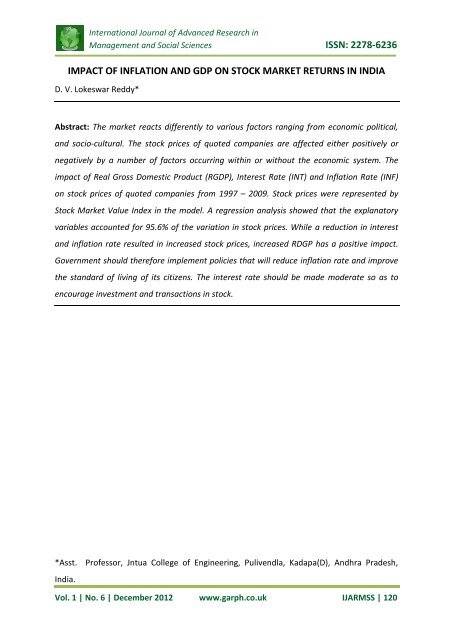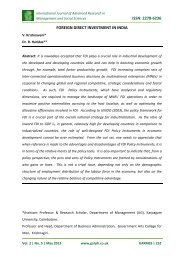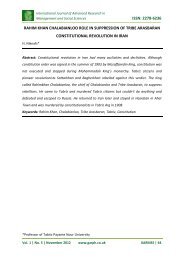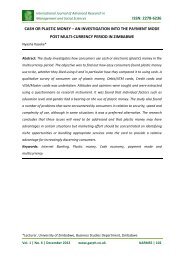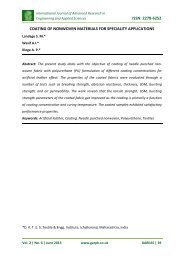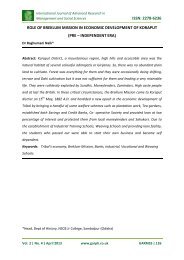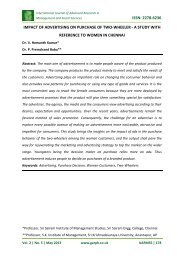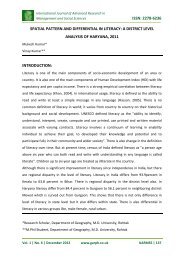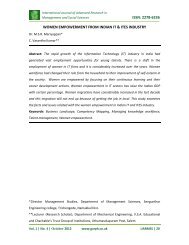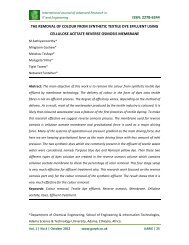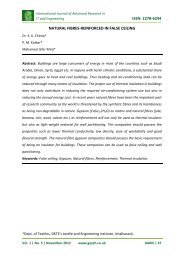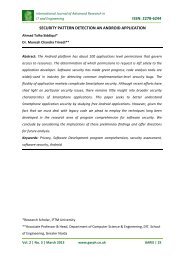impact of inflatation and gdp on stock market returns in ... - Garph.co.uk
impact of inflatation and gdp on stock market returns in ... - Garph.co.uk
impact of inflatation and gdp on stock market returns in ... - Garph.co.uk
Create successful ePaper yourself
Turn your PDF publications into a flip-book with our unique Google optimized e-Paper software.
Internati<strong>on</strong>al Journal <str<strong>on</strong>g>of</str<strong>on</strong>g> Advanced Research <strong>in</strong><br />
Management <str<strong>on</strong>g>and</str<strong>on</strong>g> Social Sciences ISSN: 2278-6236<br />
IMPACT OF INFLATION AND GDP ON STOCK MARKET RETURNS IN INDIA<br />
D. V. Lokeswar Reddy*<br />
Abstract: The <strong>market</strong> reacts differently to various factors rang<strong>in</strong>g from ec<strong>on</strong>omic political,<br />
<str<strong>on</strong>g>and</str<strong>on</strong>g> socio-cultural. The <strong>stock</strong> prices <str<strong>on</strong>g>of</str<strong>on</strong>g> quoted <strong>co</strong>mpanies are affected either positively or<br />
negatively by a number <str<strong>on</strong>g>of</str<strong>on</strong>g> factors occurr<strong>in</strong>g with<strong>in</strong> or without the ec<strong>on</strong>omic system. The<br />
<str<strong>on</strong>g>impact</str<strong>on</strong>g> <str<strong>on</strong>g>of</str<strong>on</strong>g> Real Gross Domestic Product (RGDP), Interest Rate (INT) <str<strong>on</strong>g>and</str<strong>on</strong>g> Inflati<strong>on</strong> Rate (INF)<br />
<strong>on</strong> <strong>stock</strong> prices <str<strong>on</strong>g>of</str<strong>on</strong>g> quoted <strong>co</strong>mpanies from 1997 – 2009. Stock prices were represented by<br />
Stock Market Value Index <strong>in</strong> the model. A regressi<strong>on</strong> analysis showed that the explanatory<br />
variables ac<strong>co</strong>unted for 95.6% <str<strong>on</strong>g>of</str<strong>on</strong>g> the variati<strong>on</strong> <strong>in</strong> <strong>stock</strong> prices. While a reducti<strong>on</strong> <strong>in</strong> <strong>in</strong>terest<br />
<str<strong>on</strong>g>and</str<strong>on</strong>g> <strong>in</strong>flati<strong>on</strong> rate resulted <strong>in</strong> <strong>in</strong>creased <strong>stock</strong> prices, <strong>in</strong>creased RDGP has a positive <str<strong>on</strong>g>impact</str<strong>on</strong>g>.<br />
Government should therefore implement policies that will reduce <strong>in</strong>flati<strong>on</strong> rate <str<strong>on</strong>g>and</str<strong>on</strong>g> improve<br />
the st<str<strong>on</strong>g>and</str<strong>on</strong>g>ard <str<strong>on</strong>g>of</str<strong>on</strong>g> liv<strong>in</strong>g <str<strong>on</strong>g>of</str<strong>on</strong>g> its citizens. The <strong>in</strong>terest rate should be made moderate so as to<br />
en<strong>co</strong>urage <strong>in</strong>vestment <str<strong>on</strong>g>and</str<strong>on</strong>g> transacti<strong>on</strong>s <strong>in</strong> <strong>stock</strong>.<br />
*Asst.<br />
India.<br />
Pr<str<strong>on</strong>g>of</str<strong>on</strong>g>essor, Jntua College <str<strong>on</strong>g>of</str<strong>on</strong>g> Eng<strong>in</strong>eer<strong>in</strong>g, Pulivendla, Kadapa(D), Andhra Pradesh,<br />
Vol. 1 | No. 6 | December 2012 www.garph.<strong>co</strong>.<strong>uk</strong> IJARMSS | 120
Internati<strong>on</strong>al Journal <str<strong>on</strong>g>of</str<strong>on</strong>g> Advanced Research <strong>in</strong><br />
Management <str<strong>on</strong>g>and</str<strong>on</strong>g> Social Sciences ISSN: 2278-6236<br />
INTRODUCTION<br />
The <strong>stock</strong> <strong>market</strong> is a general term used to refer to an organized exchange where shares <str<strong>on</strong>g>of</str<strong>on</strong>g><br />
<strong>stock</strong> are traded. The movement <str<strong>on</strong>g>of</str<strong>on</strong>g> <strong>stock</strong> <strong>market</strong> depends <strong>on</strong> the rati<strong>on</strong>al well as the<br />
irrati<strong>on</strong>al behavior <str<strong>on</strong>g>of</str<strong>on</strong>g> the <strong>in</strong>vestor.<br />
The <strong>returns</strong> <strong>in</strong> the <strong>stock</strong> <strong>market</strong> <strong>co</strong>uld because <str<strong>on</strong>g>of</str<strong>on</strong>g> the micro ec<strong>on</strong>omic factors like pr<str<strong>on</strong>g>of</str<strong>on</strong>g>its,<br />
bus<strong>in</strong>ess growth (new orders), P/E, dividend announced <str<strong>on</strong>g>and</str<strong>on</strong>g> the like which are perta<strong>in</strong><strong>in</strong>g to<br />
a particular <strong>co</strong>mpany. Macro ec<strong>on</strong>omic factors like <strong>in</strong>flati<strong>on</strong>, GDP would also affect the overall<br />
<strong>returns</strong> <strong>in</strong> the <strong>stock</strong> <strong>market</strong>.<br />
Hence a study will be undertaken to observe the <str<strong>on</strong>g>impact</str<strong>on</strong>g> <str<strong>on</strong>g>of</str<strong>on</strong>g> <strong>in</strong>flati<strong>on</strong>, GDP <str<strong>on</strong>g>and</str<strong>on</strong>g> <strong>in</strong>terest rates<br />
<strong>on</strong> <strong>stock</strong> <strong>market</strong> <strong>returns</strong> <str<strong>on</strong>g>and</str<strong>on</strong>g> unearth the nature <str<strong>on</strong>g>and</str<strong>on</strong>g> strength <str<strong>on</strong>g>of</str<strong>on</strong>g> relati<strong>on</strong>ship between<br />
variable under study .<br />
OBJECTIVE OF THE STUDY<br />
The thesis aims to achieve the follow<strong>in</strong>g objectives.<br />
1. To study the relati<strong>on</strong>ship between <strong>stock</strong> <strong>market</strong> <strong>returns</strong> with respect to <strong>in</strong>flati<strong>on</strong>,<br />
GDP <str<strong>on</strong>g>and</str<strong>on</strong>g> <strong>in</strong>terest rates.<br />
2. To f<strong>in</strong>d the strength <str<strong>on</strong>g>of</str<strong>on</strong>g> the relati<strong>on</strong> between <strong>stock</strong> <strong>market</strong> <strong>returns</strong> with respect to<br />
SCOPE<br />
<strong>in</strong>flati<strong>on</strong> <str<strong>on</strong>g>and</str<strong>on</strong>g> GDP.<br />
The s<strong>co</strong>pe <str<strong>on</strong>g>of</str<strong>on</strong>g> the project is restricted to f<strong>in</strong>d nature <str<strong>on</strong>g>and</str<strong>on</strong>g> strength <str<strong>on</strong>g>of</str<strong>on</strong>g> relati<strong>on</strong> between <strong>stock</strong><br />
<strong>market</strong> <strong>returns</strong> with respect to <strong>in</strong>flati<strong>on</strong> <str<strong>on</strong>g>and</str<strong>on</strong>g> GDP.<br />
RESEARCH METHODOLOGY<br />
The titled thesis project shall follow the methodology menti<strong>on</strong>ed below.<br />
1. Nature <str<strong>on</strong>g>of</str<strong>on</strong>g> the Study:<br />
a. The research carried out will be descriptive <strong>in</strong> nature for the better underst<str<strong>on</strong>g>and</str<strong>on</strong>g><strong>in</strong>g <str<strong>on</strong>g>of</str<strong>on</strong>g><br />
the undertaken research analysis.<br />
b. The research will also use regressi<strong>on</strong>, <strong>co</strong>rrelati<strong>on</strong> to f<strong>in</strong>d out the nature <str<strong>on</strong>g>and</str<strong>on</strong>g> strength<br />
<str<strong>on</strong>g>of</str<strong>on</strong>g> the relati<strong>on</strong>ship between the variables under study.<br />
c. The data regard<strong>in</strong>g <strong>stock</strong> <strong>market</strong> <strong>returns</strong>, <strong>in</strong>flati<strong>on</strong>, GDP, <strong>in</strong>terest rates will be taken<br />
for the last 10 to15 years for the study.<br />
Vol. 1 | No. 6 | December 2012 www.garph.<strong>co</strong>.<strong>uk</strong> IJARMSS | 121
Internati<strong>on</strong>al Journal <str<strong>on</strong>g>of</str<strong>on</strong>g> Advanced Research <strong>in</strong><br />
Management <str<strong>on</strong>g>and</str<strong>on</strong>g> Social Sciences ISSN: 2278-6236<br />
2. Tools Used for the <strong>co</strong>llecti<strong>on</strong> <str<strong>on</strong>g>of</str<strong>on</strong>g> data:<br />
Data:<br />
i. Informati<strong>on</strong> regard<strong>in</strong>g <strong>in</strong>flati<strong>on</strong>, GDP, Stock <strong>market</strong> <strong>returns</strong> <str<strong>on</strong>g>and</str<strong>on</strong>g> <strong>in</strong>terest rates would<br />
ii.<br />
iii.<br />
iv.<br />
be <strong>co</strong>llected from the websites <str<strong>on</strong>g>of</str<strong>on</strong>g> the M<strong>in</strong>istry <str<strong>on</strong>g>of</str<strong>on</strong>g> f<strong>in</strong>ance, ec<strong>on</strong>omic survey <str<strong>on</strong>g>of</str<strong>on</strong>g> India,<br />
BSE India <str<strong>on</strong>g>and</str<strong>on</strong>g> RBI.<br />
Books will be referred to support the formati<strong>on</strong> <str<strong>on</strong>g>of</str<strong>on</strong>g> certa<strong>in</strong> c<strong>on</strong>ceptual def<strong>in</strong>iti<strong>on</strong>s <str<strong>on</strong>g>and</str<strong>on</strong>g><br />
depth knowledge <str<strong>on</strong>g>of</str<strong>on</strong>g> the subject.<br />
Journals, Magaz<strong>in</strong>es <str<strong>on</strong>g>and</str<strong>on</strong>g> newspapers will be used to accumulate the latest<br />
<strong>in</strong>formati<strong>on</strong> about the variable under study <strong>in</strong> the research.<br />
Interviews with experts will be undertaken if necessary to tap the unknown facts<br />
<str<strong>on</strong>g>and</str<strong>on</strong>g> figures <str<strong>on</strong>g>of</str<strong>on</strong>g> what I th<strong>in</strong>k might have been miss<strong>in</strong>g <strong>in</strong> the data.<br />
LIMITATIONS<br />
• The project is limited to “Impact <str<strong>on</strong>g>of</str<strong>on</strong>g> <strong>in</strong>flati<strong>on</strong>, <strong>in</strong>terest rates <str<strong>on</strong>g>and</str<strong>on</strong>g> GDP <strong>on</strong> <strong>stock</strong><br />
<strong>market</strong> <strong>returns</strong> <strong>in</strong> India”<br />
• The data regard<strong>in</strong>g <strong>stock</strong> <strong>market</strong> <strong>returns</strong>, <strong>in</strong>flati<strong>on</strong> <str<strong>on</strong>g>and</str<strong>on</strong>g> GDP will be taken for the last<br />
10 to15 years <strong>on</strong>ly for the study.<br />
• Time perspective to c<strong>on</strong>duct the study is yet another c<strong>on</strong>stra<strong>in</strong>t.<br />
INDIAN ECONOMY<br />
<br />
<br />
<br />
Fourth largest ec<strong>on</strong>omy (US$ 3 trilli<strong>on</strong> GDP) <strong>in</strong> terms <str<strong>on</strong>g>of</str<strong>on</strong>g> Purchas<strong>in</strong>g Power Parity<br />
after USA, Ch<strong>in</strong>a <str<strong>on</strong>g>and</str<strong>on</strong>g> Japan.<br />
The fundamentals <str<strong>on</strong>g>of</str<strong>on</strong>g> the Indian ec<strong>on</strong>omy have be<strong>co</strong>me str<strong>on</strong>g <str<strong>on</strong>g>and</str<strong>on</strong>g> stable. The<br />
macro-ec<strong>on</strong>omic <strong>in</strong>dicators are at present the best <strong>in</strong> the history <str<strong>on</strong>g>of</str<strong>on</strong>g> <strong>in</strong>dependent<br />
India with high growth, healthy foreign exchange reserves, <str<strong>on</strong>g>and</str<strong>on</strong>g> foreign <strong>in</strong>vestment<br />
<str<strong>on</strong>g>and</str<strong>on</strong>g> robust <strong>in</strong>crease <strong>in</strong> exports <str<strong>on</strong>g>and</str<strong>on</strong>g> low <strong>in</strong>flati<strong>on</strong> <str<strong>on</strong>g>and</str<strong>on</strong>g> <strong>in</strong>terest rates.<br />
A unique feature <str<strong>on</strong>g>of</str<strong>on</strong>g> the transiti<strong>on</strong> <str<strong>on</strong>g>of</str<strong>on</strong>g> the Indian ec<strong>on</strong>omy is that it has be<strong>co</strong>me the<br />
sec<strong>on</strong>d fastest grow<strong>in</strong>g ec<strong>on</strong>omy <str<strong>on</strong>g>of</str<strong>on</strong>g> the world <strong>in</strong> the year 2003 - 10. In the f<strong>in</strong>ancial<br />
year 2008 - 09 the GDP growth has averaged 6.9% (estimated). India has re<strong>co</strong>rded<br />
<strong>on</strong>e <str<strong>on</strong>g>of</str<strong>on</strong>g> the highest growth rates <strong>in</strong> the 1990s. The target <str<strong>on</strong>g>of</str<strong>on</strong>g> the 10th Five Year Plan<br />
(2002-07) is 8% growth rate. India's services sector grew by 9.4% <strong>in</strong> 2008-09.<br />
Vol. 1 | No. 6 | December 2012 www.garph.<strong>co</strong>.<strong>uk</strong> IJARMSS | 122
Internati<strong>on</strong>al Journal <str<strong>on</strong>g>of</str<strong>on</strong>g> Advanced Research <strong>in</strong><br />
Management <str<strong>on</strong>g>and</str<strong>on</strong>g> Social Sciences ISSN: 2278-6236<br />
The unique feature <str<strong>on</strong>g>of</str<strong>on</strong>g> Indian ec<strong>on</strong>omy has been high growth with stability. The<br />
Indian ec<strong>on</strong>omy has proven its strength <str<strong>on</strong>g>and</str<strong>on</strong>g> resilience when there have been crisis <strong>in</strong><br />
other parts <str<strong>on</strong>g>of</str<strong>on</strong>g> the world <strong>in</strong>clud<strong>in</strong>g <strong>in</strong> Asia <strong>in</strong> recent years.<br />
The foreign exchange reserves have reached a re<strong>co</strong>rd level <str<strong>on</strong>g>of</str<strong>on</strong>g> US$ 300 billi<strong>on</strong> <strong>in</strong> June,<br />
2009. The <strong>co</strong>mfortable situati<strong>on</strong> <str<strong>on</strong>g>of</str<strong>on</strong>g> Forex reserves has facilitated further relaxati<strong>on</strong><br />
<str<strong>on</strong>g>of</str<strong>on</strong>g> foreign exchange restricti<strong>on</strong>s <str<strong>on</strong>g>and</str<strong>on</strong>g> a gradual move towards greater capital ac<strong>co</strong>unt<br />
c<strong>on</strong>vertibility. Ac<strong>co</strong>rd<strong>in</strong>g to IMF (2009 report) India's Forex Policies are <strong>in</strong> l<strong>in</strong>e with<br />
global best practices.<br />
Foreign Exchange Reserves (US$ 138.84 bn) now far exceed Foreign Debt (US$ 300<br />
<br />
<br />
<br />
<br />
<br />
<br />
<br />
<br />
bn as <strong>on</strong> September, 2009).<br />
Short-term debt is less than 4 per cent <str<strong>on</strong>g>of</str<strong>on</strong>g> the reserves.<br />
In March 1991 Forex Reserves <strong>in</strong>clud<strong>in</strong>g gold stood at $5.8bn as aga<strong>in</strong>st external<br />
debt <str<strong>on</strong>g>of</str<strong>on</strong>g> $83 billi<strong>on</strong>.<br />
The external debt to GDP ratio has improved significantly from 38.7% <strong>in</strong> 1992 to<br />
17.8% <strong>in</strong> the end <str<strong>on</strong>g>of</str<strong>on</strong>g> March 2004. This is <strong>on</strong>e <str<strong>on</strong>g>of</str<strong>on</strong>g> the lowest am<strong>on</strong>g develop<strong>in</strong>g<br />
ec<strong>on</strong>omies. External debt <strong>in</strong> December 2004 was 120.9 billi<strong>on</strong> US dollars. Of this<br />
l<strong>on</strong>g-term NRI deposit is $ 27 billi<strong>on</strong>, <strong>co</strong>mmercial borrow<strong>in</strong>gs $ 24 billi<strong>on</strong>, multilateral<br />
debt $ 31 billi<strong>on</strong>, <str<strong>on</strong>g>and</str<strong>on</strong>g> bilateral debt $ 18 billi<strong>on</strong>.<br />
After a surplus <strong>in</strong> Current ac<strong>co</strong>unt for two fiscal years, 2002-03 <str<strong>on</strong>g>and</str<strong>on</strong>g> 2003-04, the<br />
current ac<strong>co</strong>unt showed a deficit <str<strong>on</strong>g>of</str<strong>on</strong>g> US$ 6.4 bn <strong>in</strong> 2008-09.<br />
Given the large foreign exchange reserves, the Government has made a premature<br />
repayment <str<strong>on</strong>g>of</str<strong>on</strong>g> US$ 3 billi<strong>on</strong> <str<strong>on</strong>g>of</str<strong>on</strong>g> 'high-<strong>co</strong>st' loans to the World Bank <str<strong>on</strong>g>and</str<strong>on</strong>g> Asian<br />
Development Bank <str<strong>on</strong>g>and</str<strong>on</strong>g> is c<strong>on</strong>sider<strong>in</strong>g further premature repayment <str<strong>on</strong>g>of</str<strong>on</strong>g> other loans.<br />
The Government has decided to (i) disc<strong>on</strong>t<strong>in</strong>ue receiv<strong>in</strong>g aid from other <strong>co</strong>untries<br />
except the follow<strong>in</strong>g n<strong>in</strong>e: Japan, UK, Germany, USA, EU, France, Italy, Canada <str<strong>on</strong>g>and</str<strong>on</strong>g><br />
the Russian Federati<strong>on</strong> <str<strong>on</strong>g>and</str<strong>on</strong>g> (ii) to make pre-payment <str<strong>on</strong>g>of</str<strong>on</strong>g> all bilateral debt owed to all<br />
the <strong>co</strong>untries except the <strong>on</strong>es menti<strong>on</strong>ed above.<br />
S<strong>in</strong>ce July 2003, India has be<strong>co</strong>me a net creditor to the IMF, after hav<strong>in</strong>g been a<br />
borrower <strong>in</strong> the past.<br />
The Government has written <str<strong>on</strong>g>of</str<strong>on</strong>g>f debts <str<strong>on</strong>g>of</str<strong>on</strong>g> US$ 30 milli<strong>on</strong> due from seven heavily<br />
<strong>in</strong>debted <strong>co</strong>untries as part <str<strong>on</strong>g>of</str<strong>on</strong>g> the "India Development Initiative" announced <strong>in</strong><br />
Vol. 1 | No. 6 | December 2012 www.garph.<strong>co</strong>.<strong>uk</strong> IJARMSS | 123
ECONOMY<br />
Internati<strong>on</strong>al Journal <str<strong>on</strong>g>of</str<strong>on</strong>g> Advanced Research <strong>in</strong><br />
Management <str<strong>on</strong>g>and</str<strong>on</strong>g> Social Sciences ISSN: 2278-6236<br />
February 2003. The <strong>in</strong>terest rate c<strong>on</strong>t<strong>in</strong>ues to be reduced <str<strong>on</strong>g>and</str<strong>on</strong>g> is around 6%. This is<br />
the lowest <strong>in</strong> the last thirty years <str<strong>on</strong>g>and</str<strong>on</strong>g> it is stimulat<strong>in</strong>g c<strong>on</strong>sumpti<strong>on</strong> <str<strong>on</strong>g>and</str<strong>on</strong>g> <strong>in</strong>vestment.<br />
After reach<strong>in</strong>g an all-time low <str<strong>on</strong>g>of</str<strong>on</strong>g> Rs.49.06 per US dollar <strong>in</strong> May, 2002, the rupee has<br />
strengthened aga<strong>in</strong>st the dollar reach<strong>in</strong>g a rate <str<strong>on</strong>g>of</str<strong>on</strong>g> US$ 1 = Rs.43.51 <strong>in</strong> June 30, 2009.<br />
The <strong>in</strong>flati<strong>on</strong> rate has been c<strong>on</strong>ta<strong>in</strong>ed at 5.5 percent <strong>in</strong> 2003-04.The <strong>in</strong>flati<strong>on</strong> rate <strong>in</strong><br />
2004-5 has been slightly higher at 6% but has slowed down at the beg<strong>in</strong>n<strong>in</strong>g <str<strong>on</strong>g>of</str<strong>on</strong>g> the<br />
current year 2008 - 09 at 9%.<br />
The seventh largest <str<strong>on</strong>g>and</str<strong>on</strong>g> sec<strong>on</strong>d most populous <strong>co</strong>untry <strong>in</strong> the world, India has l<strong>on</strong>g been<br />
c<strong>on</strong>sidered a <strong>co</strong>untry <str<strong>on</strong>g>of</str<strong>on</strong>g> unrealised potential. A new spirit <str<strong>on</strong>g>of</str<strong>on</strong>g> ec<strong>on</strong>omic freedom is now<br />
stirr<strong>in</strong>g <strong>in</strong> the <strong>co</strong>untry, br<strong>in</strong>g<strong>in</strong>g sweep<strong>in</strong>g changes <strong>in</strong> its wake. A series <str<strong>on</strong>g>of</str<strong>on</strong>g> ambitious<br />
ec<strong>on</strong>omic reforms aimed at deregulat<strong>in</strong>g the <strong>co</strong>untry <str<strong>on</strong>g>and</str<strong>on</strong>g> stimulat<strong>in</strong>g foreign <strong>in</strong>vestment has<br />
moved India firmly <strong>in</strong>to the fr<strong>on</strong>t ranks <str<strong>on</strong>g>of</str<strong>on</strong>g> the rapidly grow<strong>in</strong>g Asia Pacific regi<strong>on</strong> <str<strong>on</strong>g>and</str<strong>on</strong>g><br />
unleashed the latent strengths <str<strong>on</strong>g>of</str<strong>on</strong>g> a <strong>co</strong>mplex <str<strong>on</strong>g>and</str<strong>on</strong>g> rapidly chang<strong>in</strong>g nati<strong>on</strong>.<br />
India's process <str<strong>on</strong>g>of</str<strong>on</strong>g> ec<strong>on</strong>omic reform is firmly rooted <strong>in</strong> a political c<strong>on</strong>sensus that spans her<br />
diverse political parties. India's democracy is a known <str<strong>on</strong>g>and</str<strong>on</strong>g> stable factor, which has taken<br />
deep roots over nearly half a century. Importantly, India has no fundamental c<strong>on</strong>flict<br />
between its political <str<strong>on</strong>g>and</str<strong>on</strong>g> ec<strong>on</strong>omic systems. Its political <strong>in</strong>stituti<strong>on</strong>s have fostered an open<br />
society with str<strong>on</strong>g <strong>co</strong>llective <str<strong>on</strong>g>and</str<strong>on</strong>g> <strong>in</strong>dividual rights <str<strong>on</strong>g>and</str<strong>on</strong>g> an envir<strong>on</strong>ment supportive <str<strong>on</strong>g>of</str<strong>on</strong>g> free<br />
ec<strong>on</strong>omic enterprise.<br />
India's time tested <strong>in</strong>stituti<strong>on</strong>s <str<strong>on</strong>g>of</str<strong>on</strong>g>fer foreign <strong>in</strong>vestors a transparent envir<strong>on</strong>ment that<br />
guarantees the security <str<strong>on</strong>g>of</str<strong>on</strong>g> their l<strong>on</strong>g term <strong>in</strong>vestments. These <strong>in</strong>clude a free <str<strong>on</strong>g>and</str<strong>on</strong>g> vibrant<br />
press, a judiciary which can <str<strong>on</strong>g>and</str<strong>on</strong>g> does overrule the government, a sophisticated legal <str<strong>on</strong>g>and</str<strong>on</strong>g><br />
ac<strong>co</strong>unt<strong>in</strong>g system <str<strong>on</strong>g>and</str<strong>on</strong>g> a user friendly <strong>in</strong>tellectual <strong>in</strong>frastructure. India's dynamic <str<strong>on</strong>g>and</str<strong>on</strong>g> highly<br />
<strong>co</strong>mpetitive private sector has l<strong>on</strong>g been the backb<strong>on</strong>e <str<strong>on</strong>g>of</str<strong>on</strong>g> its ec<strong>on</strong>omic activity. It ac<strong>co</strong>unts<br />
for over 75% <str<strong>on</strong>g>of</str<strong>on</strong>g> its Gross Domestic Product <str<strong>on</strong>g>and</str<strong>on</strong>g> <str<strong>on</strong>g>of</str<strong>on</strong>g>fers c<strong>on</strong>siderable s<strong>co</strong>pe for jo<strong>in</strong>t ventures<br />
<str<strong>on</strong>g>and</str<strong>on</strong>g> <strong>co</strong>llaborati<strong>on</strong>s.<br />
Today, India is <strong>on</strong>e <str<strong>on</strong>g>of</str<strong>on</strong>g> the most excit<strong>in</strong>g emerg<strong>in</strong>g <strong>market</strong>s <strong>in</strong> the world. Skilled managerial<br />
<str<strong>on</strong>g>and</str<strong>on</strong>g> technical manpower that match the best available <strong>in</strong> the world <str<strong>on</strong>g>and</str<strong>on</strong>g> a middle class<br />
whose size exceeds the populati<strong>on</strong> <str<strong>on</strong>g>of</str<strong>on</strong>g> the USA or the European Uni<strong>on</strong>, provide India with a<br />
dist<strong>in</strong>ct cutt<strong>in</strong>g edge <strong>in</strong> global <strong>co</strong>mpetiti<strong>on</strong>.<br />
Vol. 1 | No. 6 | December 2012 www.garph.<strong>co</strong>.<strong>uk</strong> IJARMSS | 124
Internati<strong>on</strong>al Journal <str<strong>on</strong>g>of</str<strong>on</strong>g> Advanced Research <strong>in</strong><br />
Management <str<strong>on</strong>g>and</str<strong>on</strong>g> Social Sciences ISSN: 2278-6236<br />
GDP<br />
Ec<strong>on</strong>omic growth is measured <strong>in</strong> terms <str<strong>on</strong>g>of</str<strong>on</strong>g> an <strong>in</strong>crease <strong>in</strong> the size <str<strong>on</strong>g>of</str<strong>on</strong>g> a nati<strong>on</strong>’s ec<strong>on</strong>omy. A<br />
broad measure <str<strong>on</strong>g>of</str<strong>on</strong>g> an ec<strong>on</strong>omy’s output. A most widely used measure <str<strong>on</strong>g>of</str<strong>on</strong>g> ec<strong>on</strong>omic output is<br />
the Gross Domestic Product.<br />
Gross Domestic Product (GDP), a calculati<strong>on</strong> method <strong>in</strong> nati<strong>on</strong>al ac<strong>co</strong>unt<strong>in</strong>g is def<strong>in</strong>ed as<br />
the total value <str<strong>on</strong>g>of</str<strong>on</strong>g> f<strong>in</strong>al goods <str<strong>on</strong>g>and</str<strong>on</strong>g> services produced with<strong>in</strong> a <strong>co</strong>untry's borders <strong>in</strong> a year,<br />
regardless <str<strong>on</strong>g>of</str<strong>on</strong>g> ownership. GDP measures <strong>on</strong>ly f<strong>in</strong>al goods <str<strong>on</strong>g>and</str<strong>on</strong>g> services, that is those goods<br />
<str<strong>on</strong>g>and</str<strong>on</strong>g> services that are c<strong>on</strong>sumed by their f<strong>in</strong>al user, <str<strong>on</strong>g>and</str<strong>on</strong>g> not used as an <strong>in</strong>put <strong>in</strong>to other<br />
goods. Measur<strong>in</strong>g <strong>in</strong>termediate goods <str<strong>on</strong>g>and</str<strong>on</strong>g> services would lead to double <strong>co</strong>unt<strong>in</strong>g <str<strong>on</strong>g>of</str<strong>on</strong>g><br />
ec<strong>on</strong>omic activity with<strong>in</strong> a <strong>co</strong>untry. This dist<strong>in</strong>cti<strong>on</strong> also removes transfers between<br />
<strong>in</strong>dividuals <str<strong>on</strong>g>and</str<strong>on</strong>g> <strong>co</strong>mpanies from GDP.<br />
There are three approaches to calculat<strong>in</strong>g GDP with al render<strong>in</strong>g same results.<br />
Expenditure Approach: Calculates the f<strong>in</strong>al spend<strong>in</strong>g <strong>on</strong> goods <str<strong>on</strong>g>and</str<strong>on</strong>g> services.<br />
Product Approach: Calculates the <strong>market</strong> value <str<strong>on</strong>g>of</str<strong>on</strong>g> goods <str<strong>on</strong>g>and</str<strong>on</strong>g> service produced.<br />
In<strong>co</strong>me Approach: Sums the <strong>in</strong><strong>co</strong>me received by all products <strong>in</strong> the <strong>co</strong>untry.<br />
Expenditure Approach to determ<strong>in</strong>e GDP:<br />
GDP = private c<strong>on</strong>sumpti<strong>on</strong> + government purchases + <strong>in</strong>vestment + net<br />
exports<br />
C<strong>on</strong>sumpti<strong>on</strong> is calculated by add<strong>in</strong>g durable <str<strong>on</strong>g>and</str<strong>on</strong>g> n<strong>on</strong> - durable <str<strong>on</strong>g>and</str<strong>on</strong>g> service<br />
expenditures. It is unaffected by the estimated value <str<strong>on</strong>g>of</str<strong>on</strong>g> imported goods.<br />
The <strong>in</strong>vestment <strong>in</strong>cludes <strong>in</strong>vestment <strong>in</strong> fixed assets <str<strong>on</strong>g>and</str<strong>on</strong>g> <strong>in</strong>crease <strong>in</strong> <strong>in</strong>ventory.<br />
Government purchases are equal to the government expenditures less government<br />
transfer payments.<br />
Net Exports are exports m<strong>in</strong>us imports.<br />
NOMINAL GDP AND REAL GDP<br />
Without any adjustment, the GDP calculati<strong>on</strong> is distorted by <strong>in</strong>flati<strong>on</strong>. This unadjusted GDP<br />
is known as the nom<strong>in</strong>al GDP. In practice, GDP is adjusted by divid<strong>in</strong>g the nom<strong>in</strong>al GDP by a<br />
price deflator to arrive at the real GDP.<br />
Vol. 1 | No. 6 | December 2012 www.garph.<strong>co</strong>.<strong>uk</strong> IJARMSS | 125
Internati<strong>on</strong>al Journal <str<strong>on</strong>g>of</str<strong>on</strong>g> Advanced Research <strong>in</strong><br />
Management <str<strong>on</strong>g>and</str<strong>on</strong>g> Social Sciences ISSN: 2278-6236<br />
In an <strong>in</strong>flati<strong>on</strong>ary envir<strong>on</strong>ment, the nom<strong>in</strong>al GDP is greater than the real GDP. If the price<br />
deflator is not known, an implicit price deflator can be calculated by divid<strong>in</strong>g the nom<strong>in</strong>al<br />
GDP by the real GDP:<br />
Implicit Price Deflator = Nom<strong>in</strong>al GDP / Real GDP<br />
The <strong>co</strong>mpositi<strong>on</strong> <str<strong>on</strong>g>of</str<strong>on</strong>g> this deflator is different from that <str<strong>on</strong>g>of</str<strong>on</strong>g> the c<strong>on</strong>sumer price <strong>in</strong>dex <strong>in</strong> that<br />
the GDP deflator <strong>in</strong>cludes government goods, <strong>in</strong>vestment goods, <str<strong>on</strong>g>and</str<strong>on</strong>g> exports rather than<br />
the traditi<strong>on</strong>al c<strong>on</strong>sumer-oriented basket <str<strong>on</strong>g>of</str<strong>on</strong>g> goods.GDP usually is reported each quarter <strong>on</strong><br />
a seas<strong>on</strong>ally adjusted annualized basis.<br />
GDP GROWTH<br />
Countries seek to <strong>in</strong>crease their GDP <strong>in</strong> order to <strong>in</strong>crease their st<str<strong>on</strong>g>and</str<strong>on</strong>g>ard <str<strong>on</strong>g>of</str<strong>on</strong>g> liv<strong>in</strong>g. Note that<br />
growth <strong>in</strong> GDP does not result <strong>in</strong> <strong>in</strong>creased purchas<strong>in</strong>g power if the growth is due to<br />
<strong>in</strong>flati<strong>on</strong> or populati<strong>on</strong> <strong>in</strong>crease. For purchas<strong>in</strong>g power, it is the real, per capita GDP that is<br />
important.<br />
While <strong>in</strong>vestment is an important factor <strong>in</strong> a nati<strong>on</strong>'s GDP growth, even more important is<br />
greater respect for laws <str<strong>on</strong>g>and</str<strong>on</strong>g> c<strong>on</strong>tracts.<br />
GDP versus GNP<br />
GDP measures the output <str<strong>on</strong>g>of</str<strong>on</strong>g> goods <str<strong>on</strong>g>and</str<strong>on</strong>g> services with<strong>in</strong> the borders <str<strong>on</strong>g>of</str<strong>on</strong>g> the <strong>co</strong>untry. Gross<br />
Nati<strong>on</strong>al Product (GNP) measures the output <str<strong>on</strong>g>of</str<strong>on</strong>g> a nati<strong>on</strong>'s factors <str<strong>on</strong>g>of</str<strong>on</strong>g> producti<strong>on</strong>, regardless<br />
<str<strong>on</strong>g>of</str<strong>on</strong>g> whether the factors are located with<strong>in</strong> the <strong>co</strong>untry's borders. For example, the output <str<strong>on</strong>g>of</str<strong>on</strong>g><br />
workers located <strong>in</strong> another <strong>co</strong>untry would be <strong>in</strong>cluded <strong>in</strong> the workers' home <strong>co</strong>untry GNP<br />
but not its GDP. The Gross Nati<strong>on</strong>al Product can be either larger or smaller than the<br />
<strong>co</strong>untry's GDP depend<strong>in</strong>g <strong>on</strong> the number <str<strong>on</strong>g>of</str<strong>on</strong>g> its citizens work<strong>in</strong>g outside its borders <str<strong>on</strong>g>and</str<strong>on</strong>g> the<br />
number <str<strong>on</strong>g>of</str<strong>on</strong>g> other <strong>co</strong>untry's citizens work<strong>in</strong>g with<strong>in</strong> its borders.<br />
Vol. 1 | No. 6 | December 2012 www.garph.<strong>co</strong>.<strong>uk</strong> IJARMSS | 126
Internati<strong>on</strong>al Journal <str<strong>on</strong>g>of</str<strong>on</strong>g> Advanced Research <strong>in</strong><br />
Management <str<strong>on</strong>g>and</str<strong>on</strong>g> Social Sciences ISSN: 2278-6236<br />
YEAR GDP GROWTH RATE (X) SENSEX (Y) X-X' Y-Y' (X-X')*(Y-Y') (X-X')^2 (Y-Y')^2 X^2<br />
1990 - 1991 5.00 1908.85 -1.56 -4670.65 7286.21 2.43 21814943.40 25<br />
1991 - 1992 5.10 2615.37 -1.46 -3964.13 5787.63 2.13 15714302.87 26.01<br />
1992 - 1993 5.10 3346.06 -1.46 -3233.44 4720.82 2.13 10455114.83 26.01<br />
1993 - 1994 5.90 3926.90 -0.66 -2652.60 1750.71 0.44 7036270.84 34.81<br />
1994 - 1995 7.30 3110.49 0.74 -3469.01 -2567.07 0.55 12034009.57 53.29<br />
1995 - 1996 7.30 3085.20 0.74 -3494.30 -2585.78 0.55 12210111.52 53.29<br />
1996 - 1997 7.80 3658.98 1.24 -2920.52 -3621.44 1.54 8529419.55 60.84<br />
1997 - 1998 4.80 3055.41 -1.76 -3524.09 6202.39 3.10 12419189.18 23.04<br />
1998 - 1999 6.50 5005.82 -0.06 -1573.68 94.42 0.00 2476459.30 42.25<br />
1999 - 2000 6.10 3972.12 -0.46 -2607.38 1199.39 0.21 6798414.82 37.21<br />
2000 - 2001 4.40 3262.33 -2.16 -3317.17 7165.08 4.67 11003596.91 19.36<br />
2001 - 2002 5.60 3377.28 -0.96 -3202.22 3074.13 0.92 10254193.72 31.36<br />
2002 - 2003 4.40 5838.96 -2.16 -740.54 1599.56 4.67 548395.05 19.36<br />
2003 - 2004 8.10 6602.69 1.54 23.19 35.72 2.37 537.92 65.61<br />
2004 - 2005 7.30 8206.00 0.74 1626.50 1203.61 0.55 2645512.01 53.29<br />
2005 - 2006 8.40 9397.36 1.84 2817.86 5184.87 3.39 7940351.89 70.56<br />
2006 - 2007 9.20 13786.00 2.64 7206.50 19025.17 6.97 51933685.49 84.64<br />
2007 - 2008 9.00 20206.12 2.44 13626.62 33248.96 5.95 185684854.38 81<br />
2008 - 2009 7.40 9328.00 0.84 2748.50 2308.74 0.71 7554268.74 54.76<br />
2009 - 2010 6.50 17900.00 -0.06 11320.50 -679.23 0.00 128153788.17 42.25<br />
SUM 131.20 131589.94 0.00 0.00 90433.89 43.27 515207420.16 903.94<br />
MEAN 6.56 6579.50 0.00 0.00 4521.69 2.16 25760371.01<br />
Slope(regressi<strong>on</strong> ) = <strong>co</strong>var/ var (x)<br />
Covariance 4521.69<br />
Variance X 2.16<br />
Variance Y 25760371.01<br />
Slope 2090.09<br />
SD(X) 1.22<br />
SD(Y) 1614.25<br />
Corelati<strong>on</strong> : <strong>co</strong>var / SD(X) * SD (Y)<br />
r 2.30<br />
St<str<strong>on</strong>g>and</str<strong>on</strong>g>ard Error : Sqrt{Sum(Y-Y')^2 /<br />
n-2}<br />
Se 5350.01<br />
Vol. 1 | No. 6 | December 2012 www.garph.<strong>co</strong>.<strong>uk</strong> IJARMSS | 127
Internati<strong>on</strong>al Journal <str<strong>on</strong>g>of</str<strong>on</strong>g> Advanced Research <strong>in</strong><br />
Management <str<strong>on</strong>g>and</str<strong>on</strong>g> Social Sciences ISSN: 2278-6236<br />
Regressi<strong>on</strong> L<strong>in</strong>e : Y = a + bx<br />
Where a = Y(mean) - bX(mean)<br />
b = {SUMXY - n (meanX)*(meanY)} / {SUM(X*X) -<br />
n(meanX)*(meanX)}<br />
Value<br />
a 3054.22<br />
b 537.39<br />
Regressi<strong>on</strong> L<strong>in</strong>e<br />
Y = 3054.22 + 537.39 X<br />
St<str<strong>on</strong>g>and</str<strong>on</strong>g>ard Error <str<strong>on</strong>g>of</str<strong>on</strong>g> Slope (b) : Se / Sqrt(SUM X^2 - n X' ^2)<br />
Sb 813.34<br />
Real Gross Domestic Product (RGDP) <str<strong>on</strong>g>and</str<strong>on</strong>g> Stock Prices<br />
The measure <str<strong>on</strong>g>of</str<strong>on</strong>g> aggregate output <strong>in</strong> the nati<strong>on</strong>al <strong>in</strong><strong>co</strong>me ac<strong>co</strong>unts is Gross Domestic<br />
Product (GDP) ac<strong>co</strong>rd<strong>in</strong>g to Blanchard (1997). He stated that there are three ways <str<strong>on</strong>g>of</str<strong>on</strong>g><br />
th<strong>in</strong>k<strong>in</strong>g about an ec<strong>on</strong>omy’s GDP. These are that:<br />
• GDP is the value <str<strong>on</strong>g>of</str<strong>on</strong>g> the f<strong>in</strong>al goods <str<strong>on</strong>g>and</str<strong>on</strong>g> services produced <strong>in</strong> the ec<strong>on</strong>omy dur<strong>in</strong>g a given<br />
period<br />
• GDP is the sum <str<strong>on</strong>g>of</str<strong>on</strong>g> value added <strong>in</strong> the ec<strong>on</strong>omy dur<strong>in</strong>g a given period ,<br />
• GDP is the sum <str<strong>on</strong>g>of</str<strong>on</strong>g> <strong>in</strong><strong>co</strong>mes <strong>in</strong> the ec<strong>on</strong>omy dur<strong>in</strong>g a given period.<br />
Nom<strong>in</strong>al GDP is simply the sum <str<strong>on</strong>g>of</str<strong>on</strong>g> the quantities <str<strong>on</strong>g>of</str<strong>on</strong>g> f<strong>in</strong>al goods produced times their current<br />
price. Ec<strong>on</strong>omists use nom<strong>in</strong>al for variables expressed <strong>in</strong> units <str<strong>on</strong>g>of</str<strong>on</strong>g> the currency <str<strong>on</strong>g>of</str<strong>on</strong>g> the<br />
relevant <strong>co</strong>untry.<br />
Nom<strong>in</strong>al GDP <strong>in</strong>creases over time for two reas<strong>on</strong>s. The first is that the producti<strong>on</strong> <str<strong>on</strong>g>of</str<strong>on</strong>g> most<br />
goods <strong>in</strong>creases over time. The sec<strong>on</strong>d is that the price <str<strong>on</strong>g>of</str<strong>on</strong>g> most goods <strong>in</strong>creases over time.<br />
In order to measure producti<strong>on</strong> <str<strong>on</strong>g>and</str<strong>on</strong>g> its change over time, the effect <str<strong>on</strong>g>of</str<strong>on</strong>g> <strong>in</strong>creas<strong>in</strong>g prices<br />
Vol. 1 | No. 6 | December 2012 www.garph.<strong>co</strong>.<strong>uk</strong> IJARMSS | 128
Internati<strong>on</strong>al Journal <str<strong>on</strong>g>of</str<strong>on</strong>g> Advanced Research <strong>in</strong><br />
Management <str<strong>on</strong>g>and</str<strong>on</strong>g> Social Sciences ISSN: 2278-6236<br />
need to be elim<strong>in</strong>ated. Hence, focus is <strong>on</strong> real GDP rather than nom<strong>in</strong>al. Carstrom (2002)<br />
expressed that <strong>stock</strong> prices <str<strong>on</strong>g>and</str<strong>on</strong>g> future RGDP growth are related. He gave two prom<strong>in</strong>ent<br />
explanati<strong>on</strong>s for this; the first explanati<strong>on</strong> was that changes <strong>in</strong> <strong>in</strong>formati<strong>on</strong> about the future<br />
<strong>co</strong>urse <str<strong>on</strong>g>of</str<strong>on</strong>g> RGDP cause prices to change <strong>in</strong> the <strong>stock</strong> <strong>market</strong> today.<br />
He also said that changes <strong>in</strong> <strong>stock</strong> prices, no matter what the source is, will reduce firms’<br />
asset positi<strong>on</strong>s <str<strong>on</strong>g>and</str<strong>on</strong>g> affect the <strong>co</strong>st <str<strong>on</strong>g>of</str<strong>on</strong>g> their borrow<strong>in</strong>g. When it <strong>co</strong>sts more for firms to<br />
borrow m<strong>on</strong>ey, they borrow <str<strong>on</strong>g>and</str<strong>on</strong>g> <strong>in</strong>vest less, RGDP growth slows. Changes <strong>in</strong> <strong>in</strong>formati<strong>on</strong><br />
about the future <strong>co</strong>urse <str<strong>on</strong>g>of</str<strong>on</strong>g> RGDP may cause prices to change <strong>in</strong> the <strong>stock</strong> <strong>market</strong>. This<br />
explanati<strong>on</strong> suggests that while <strong>stock</strong> prices are used to predict future ec<strong>on</strong>omic activity,<br />
the actual causality is from future GDP growth <strong>in</strong> current <strong>stock</strong> prices.<br />
GDP - SENSEX<br />
25000<br />
20000<br />
20206.12<br />
17900.00<br />
15000<br />
13786.00<br />
8206.00<br />
9397.36 9328.00<br />
10000<br />
5838.96<br />
6602.69<br />
1908.85<br />
2615.37 3346.06 3926.90 3110.49 3085.20<br />
3658.98<br />
5005.82<br />
5000<br />
3972.12<br />
3055.41 3262.3377.28<br />
5.00 5.10 5.10 5.90 7.30 7.30 7.80 4.80 6.50 6.10 4.40 5.60 4.40 8.10 7.30 8.40 9.20 9.00 7.40 6.50<br />
0<br />
1 2 3 4 5 6 7 8 9 10 11 12 13 14 15 16 17 18 19 20<br />
YEARS<br />
SENSEX (Y)<br />
GDP GROWTH RATE (X)<br />
INFLATION<br />
Simply put, <strong>in</strong>flati<strong>on</strong> is a situati<strong>on</strong> <strong>in</strong> the ec<strong>on</strong>omy where, there is more m<strong>on</strong>ey chas<strong>in</strong>g less<br />
<str<strong>on</strong>g>of</str<strong>on</strong>g> goods <str<strong>on</strong>g>and</str<strong>on</strong>g> services. In other words, it means there is more supply/availability <str<strong>on</strong>g>of</str<strong>on</strong>g> m<strong>on</strong>ey <strong>in</strong><br />
the ec<strong>on</strong>omy <str<strong>on</strong>g>and</str<strong>on</strong>g> there are less <str<strong>on</strong>g>of</str<strong>on</strong>g> goods <str<strong>on</strong>g>and</str<strong>on</strong>g> services to buy with that <strong>in</strong>creased m<strong>on</strong>ey.<br />
Thus goods <str<strong>on</strong>g>and</str<strong>on</strong>g> services <strong>co</strong>mm<str<strong>on</strong>g>and</str<strong>on</strong>g>s a higher price than actual as more people are will<strong>in</strong>g to<br />
pay a higher value to buy the same goods. In this <strong>in</strong>flati<strong>on</strong>ary situati<strong>on</strong>, there is no real<br />
growth <strong>in</strong> the output <str<strong>on</strong>g>of</str<strong>on</strong>g> the ec<strong>on</strong>omy per se. It’s simply more m<strong>on</strong>ey chas<strong>in</strong>g few goods <str<strong>on</strong>g>and</str<strong>on</strong>g><br />
services. For a brief moment let us suspend belief <str<strong>on</strong>g>and</str<strong>on</strong>g> imag<strong>in</strong>e that all the m<strong>on</strong>ey <strong>in</strong> the<br />
Vol. 1 | No. 6 | December 2012 www.garph.<strong>co</strong>.<strong>uk</strong> IJARMSS | 129
Internati<strong>on</strong>al Journal <str<strong>on</strong>g>of</str<strong>on</strong>g> Advanced Research <strong>in</strong><br />
Management <str<strong>on</strong>g>and</str<strong>on</strong>g> Social Sciences ISSN: 2278-6236<br />
<strong>co</strong>untry is just Rs100. And all the goods produced <strong>in</strong> the <strong>co</strong>untry are just five apples.<br />
Naturally, each apple will fetch Rs20. Next year, the m<strong>on</strong>ey doubles to Rs200 but the total<br />
goods produced are aga<strong>in</strong> five apples. Each apple will now fetch Rs40. That is what <strong>in</strong>flati<strong>on</strong><br />
is all about — too much m<strong>on</strong>ey chas<strong>in</strong>g too few goods. Inflati<strong>on</strong> is a hydra-headed m<strong>on</strong>ster,<br />
which has a desirable as well as an undesirable effect. The desirable part is that when prices<br />
are high, bus<strong>in</strong>essmen get more value for their goods, which entices them to produce more.<br />
The undesirable part is that when prices shoot up, people are forced to restrict their<br />
purchases, which can lead to recessi<strong>on</strong>. Ris<strong>in</strong>g oil prices have been <strong>on</strong>e <str<strong>on</strong>g>of</str<strong>on</strong>g> the ma<strong>in</strong> causes <str<strong>on</strong>g>of</str<strong>on</strong>g><br />
<strong>in</strong>flati<strong>on</strong> though that is not all. A weak m<strong>on</strong>so<strong>on</strong> till recently brought about a shortage <strong>in</strong><br />
food items <str<strong>on</strong>g>and</str<strong>on</strong>g> some <strong>co</strong>mmodities. There had also been a surge <strong>in</strong> foreign exchange <strong>in</strong>flows<br />
<str<strong>on</strong>g>and</str<strong>on</strong>g> to keep the price <str<strong>on</strong>g>of</str<strong>on</strong>g> the rupee stable, the RBI has been purchas<strong>in</strong>g dollars — <str<strong>on</strong>g>and</str<strong>on</strong>g> that<br />
means pump<strong>in</strong>g <strong>in</strong> rupees <strong>in</strong>to the system.<br />
To suck out the excess rupees from the system, the RBI follows a policy <str<strong>on</strong>g>of</str<strong>on</strong>g> sterile<br />
<strong>in</strong>terventi<strong>on</strong> — which translates <strong>in</strong>to the RBI issu<strong>in</strong>g government securities. There is a limit<br />
to the quantum <str<strong>on</strong>g>of</str<strong>on</strong>g> government securities the RBI can issue <str<strong>on</strong>g>and</str<strong>on</strong>g> its <strong>stock</strong> <str<strong>on</strong>g>of</str<strong>on</strong>g> securities at the<br />
moment is <strong>in</strong>significant. The RBI can tighten the m<strong>on</strong>etary policy by rais<strong>in</strong>g <strong>in</strong>terest rates,<br />
however, higher <strong>in</strong>terest rates will hit the balance sheet <str<strong>on</strong>g>of</str<strong>on</strong>g> banks that have large <strong>in</strong>terest<br />
rate exposures. Moreover, the RBI is also the banker to the government by virtue <str<strong>on</strong>g>of</str<strong>on</strong>g> which,<br />
it tends to keep the <strong>in</strong>terest rate low so that the government's <strong>in</strong>terest <strong>co</strong>st rema<strong>in</strong>s <strong>in</strong><br />
c<strong>on</strong>trol.<br />
Types <str<strong>on</strong>g>of</str<strong>on</strong>g> <strong>in</strong>flati<strong>on</strong>:<br />
Inflati<strong>on</strong> is caused by a <strong>co</strong>mb<strong>in</strong>ati<strong>on</strong> <str<strong>on</strong>g>of</str<strong>on</strong>g> four factors.<br />
<br />
<br />
<br />
<br />
The supply <str<strong>on</strong>g>of</str<strong>on</strong>g> m<strong>on</strong>ey goes up.<br />
The supply <str<strong>on</strong>g>of</str<strong>on</strong>g> goods goes down.<br />
Dem<str<strong>on</strong>g>and</str<strong>on</strong>g> for m<strong>on</strong>ey goes down.<br />
Dem<str<strong>on</strong>g>and</str<strong>on</strong>g> for goods goes up.<br />
"Inflati<strong>on</strong> can result from a decrease <strong>in</strong> aggregate supply. The two ma<strong>in</strong> sources <str<strong>on</strong>g>of</str<strong>on</strong>g> decrease<br />
<strong>in</strong> aggregate supply are<br />
<br />
<br />
An <strong>in</strong>crease <strong>in</strong> wage rates<br />
An <strong>in</strong>crease <strong>in</strong> the prices <str<strong>on</strong>g>of</str<strong>on</strong>g> raw materials<br />
Vol. 1 | No. 6 | December 2012 www.garph.<strong>co</strong>.<strong>uk</strong> IJARMSS | 130
Internati<strong>on</strong>al Journal <str<strong>on</strong>g>of</str<strong>on</strong>g> Advanced Research <strong>in</strong><br />
Management <str<strong>on</strong>g>and</str<strong>on</strong>g> Social Sciences ISSN: 2278-6236<br />
These sources <str<strong>on</strong>g>of</str<strong>on</strong>g> a decrease <strong>in</strong> aggregate supply operate by <strong>in</strong>creas<strong>in</strong>g <strong>co</strong>sts, <str<strong>on</strong>g>and</str<strong>on</strong>g> the<br />
result<strong>in</strong>g <strong>in</strong>flati<strong>on</strong> is called <strong>co</strong>st-push <strong>in</strong>flati<strong>on</strong>.<br />
YEAR INFLATION CPI (X) SENSEX (Y) X-X' Y-Y' (X-X')*(Y-Y') (X-X')^2 (Y-Y')^2 X^2<br />
1990 - 1991 13.70 1908.85 5.78 -6863.81 -39672.84 33.41 47111924.32 187.7<br />
1991 - 1992 13.5 2615.37 5.58 -6157.29 -34357.69 31.14 37912252.98 182.3<br />
1992 - 1993 9.6 3346.06 1.68 -5426.60 -9116.69 2.82 29448016.50 92.16<br />
1993 - 1994 7.5 3926.90 -0.42 -4845.76 2035.22 0.18 23481415.82 56.25<br />
1994 - 1995 10.10 3110.49 2.18 -5662.17 -12343.54 4.75 32060199.31 102<br />
1995 - 1996 9.20 3085.20 1.28 -5687.46 -7279.95 1.64 32347231.58 84.64<br />
1996 - 1997 7.20 3658.98 -0.72 -5113.68 3681.85 0.52 26149750.42 51.84<br />
1997 - 1998 13.10 3055.41 5.18 -5717.25 -29615.37 26.83 32686978.05 171.6<br />
1998 - 1999 4.70 5005.82 -3.22 -3766.84 12129.23 10.37 14189103.68 22.09<br />
1999 - 2000 4.00 3972.12 -3.92 -4800.54 18818.13 15.37 23045209.89 16<br />
2000 - 2001 3.80 3262.33 -4.12 -5510.33 22702.57 16.97 30363766.10 14.44<br />
2001 - 2002 4.30 3377.28 -3.62 -5395.38 19531.29 13.10 29110154.12 18.49<br />
2002 - 2003 4.10 5838.96 -3.82 -2933.70 11206.74 14.59 8606611.34 16.81<br />
2003 - 2004 5.50 6602.69 -2.42 -2169.97 5251.33 5.86 4708781.37 30.25<br />
2004 - 2005 4.30 8206.00 -3.62 -566.66 2051.32 13.10 321106.58 18.49<br />
2005 - 2006 4.20 9397.36 4.20 624.70 2623.73 17.64 390246.76 17.64<br />
2006 - 2007 4.80 13786.00 4.80 5013.34 24064.02 23.04 25133551.22 23.04<br />
2007 - 2008 9.00 20206.12 9.00 11433.46 102901.12 81.00 130723946.59 81<br />
2008 - 2009 11.49 9328.00 3.57 555.34 1982.55 12.74 308399.55 132<br />
2009 - 2010 12.00 17900.00 4.08 9127.34 37239.54 16.65 83308286.80 144<br />
SUM 118.80 131589.94 0.00 0.00 -34978.40 190.65 371542502.07 1083<br />
MEAN 7.92 8772.66 0.00 0.00 -2331.89 12.71 24769500.14<br />
Slope(regressi<strong>on</strong> ) = <strong>co</strong>var/ var (x)<br />
Covariance -1748.92<br />
Variance X 9.5326<br />
Variance Y 18577125.10<br />
Slope -183.47<br />
SD(X) 3.55<br />
SD(Y) 1614.25<br />
Corelati<strong>on</strong> : <strong>co</strong>var / SD(X) * SD (Y)<br />
r -0.30<br />
St<str<strong>on</strong>g>and</str<strong>on</strong>g>ard Error : Sqrt {Sum(Y-Y')^2 / n-2}<br />
Vol. 1 | No. 6 | December 2012 www.garph.<strong>co</strong>.<strong>uk</strong> IJARMSS | 131
Internati<strong>on</strong>al Journal <str<strong>on</strong>g>of</str<strong>on</strong>g> Advanced Research <strong>in</strong><br />
Management <str<strong>on</strong>g>and</str<strong>on</strong>g> Social Sciences ISSN: 2278-6236<br />
Se 4543.26<br />
Regressi<strong>on</strong> L<strong>in</strong>e : Y = a + bx<br />
Where a = Y(mean) - bX(mean)<br />
b = {SUMXY - n (meanX)*(meanY)} / {SUM(X*X) -<br />
n(meanX)*(meanX)}<br />
Value<br />
a 11061.23<br />
b -288.96<br />
Regressi<strong>on</strong> L<strong>in</strong>e<br />
Y = 11061.23 - 288.96 X<br />
St<str<strong>on</strong>g>and</str<strong>on</strong>g>ard Error <str<strong>on</strong>g>of</str<strong>on</strong>g> Slope (b) : Se / Sqrt(SUM X^2 - n X' ^2)<br />
Sb 1124.93<br />
INFLATION AND ITS EFFECT ON STOCK PRICES<br />
Asogu(1991) was <str<strong>on</strong>g>of</str<strong>on</strong>g> the view that <strong>in</strong>flati<strong>on</strong> is generally used to distribute a situati<strong>on</strong> <str<strong>on</strong>g>of</str<strong>on</strong>g> rapid,<br />
persistent <str<strong>on</strong>g>and</str<strong>on</strong>g> unacceptable high rises <strong>in</strong> general price level <strong>in</strong> an ec<strong>on</strong>omy, result<strong>in</strong>g <strong>in</strong><br />
general loss <str<strong>on</strong>g>of</str<strong>on</strong>g> purchas<strong>in</strong>g power <str<strong>on</strong>g>of</str<strong>on</strong>g> the currency. Ac<strong>co</strong>rd<strong>in</strong>g to him, <strong>in</strong>flati<strong>on</strong> causes serious<br />
dis<strong>co</strong>mfort for c<strong>on</strong>sumers, <strong>in</strong>vestors, producers <str<strong>on</strong>g>and</str<strong>on</strong>g> the government.<br />
In a study <str<strong>on</strong>g>of</str<strong>on</strong>g> some <strong>co</strong>untries, Maynard <str<strong>on</strong>g>and</str<strong>on</strong>g> Van Ryckeghem (1975) as cited <strong>in</strong> Masha (2003),<br />
found that the l<strong>on</strong>g-run trend <str<strong>on</strong>g>of</str<strong>on</strong>g> ris<strong>in</strong>g price levels can be attributed to differences <strong>in</strong> the<br />
rates <str<strong>on</strong>g>of</str<strong>on</strong>g> growth <str<strong>on</strong>g>and</str<strong>on</strong>g> productivity <strong>in</strong> the <strong>in</strong>dustrial <str<strong>on</strong>g>and</str<strong>on</strong>g> service sectors. Other causes <str<strong>on</strong>g>of</str<strong>on</strong>g> ris<strong>in</strong>g<br />
prices are differences <strong>in</strong> the prices <str<strong>on</strong>g>and</str<strong>on</strong>g> elasticity between the two sectors, uniform growth<br />
nom<strong>in</strong>al wages <strong>in</strong> both sectors, <str<strong>on</strong>g>and</str<strong>on</strong>g> price <str<strong>on</strong>g>and</str<strong>on</strong>g> wage rigidities Some attempts have been<br />
made to study the character <str<strong>on</strong>g>of</str<strong>on</strong>g> <strong>in</strong>flati<strong>on</strong>. Asogu (1991) undertook an empirical <strong>in</strong>vestigati<strong>on</strong><br />
based <strong>on</strong> ten different specificati<strong>on</strong>s that <strong>co</strong>vered m<strong>on</strong>etary, structural <str<strong>on</strong>g>and</str<strong>on</strong>g> open ec<strong>on</strong>omy<br />
aspects <str<strong>on</strong>g>of</str<strong>on</strong>g> <strong>in</strong>flati<strong>on</strong>. The variables used <strong>in</strong>clude m<strong>on</strong>ey supply <str<strong>on</strong>g>and</str<strong>on</strong>g> its lagged values, Real<br />
Vol. 1 | No. 6 | December 2012 www.garph.<strong>co</strong>.<strong>uk</strong> IJARMSS | 132
Internati<strong>on</strong>al Journal <str<strong>on</strong>g>of</str<strong>on</strong>g> Advanced Research <strong>in</strong><br />
Management <str<strong>on</strong>g>and</str<strong>on</strong>g> Social Sciences ISSN: 2278-6236<br />
Gross Domestic Product (RGDP) <str<strong>on</strong>g>and</str<strong>on</strong>g> its lagged values, aggregate domestic credit to the<br />
ec<strong>on</strong>omy <str<strong>on</strong>g>and</str<strong>on</strong>g> its lagged values, government expenditure <str<strong>on</strong>g>and</str<strong>on</strong>g> its lagged values. Others are<br />
<strong>in</strong>dustrial producti<strong>on</strong> <strong>in</strong>dex, the import price <strong>in</strong>dex <str<strong>on</strong>g>and</str<strong>on</strong>g> an <str<strong>on</strong>g>of</str<strong>on</strong>g>ficial exchange rate <strong>in</strong> all, the<br />
models were estimated <str<strong>on</strong>g>and</str<strong>on</strong>g> the character <str<strong>on</strong>g>of</str<strong>on</strong>g> <strong>in</strong>flati<strong>on</strong> seems to be well captured.<br />
In summary, the results <str<strong>on</strong>g>of</str<strong>on</strong>g> the estimati<strong>on</strong>s suggested that real output, especially <strong>in</strong>dustrial<br />
output, net exports, current m<strong>on</strong>ey supply, domestic food prices <str<strong>on</strong>g>and</str<strong>on</strong>g> exchange rate changes<br />
were the major determ<strong>in</strong>ants <str<strong>on</strong>g>of</str<strong>on</strong>g> <strong>in</strong>flati<strong>on</strong>. The study, therefore, c<strong>on</strong>firms the importance <str<strong>on</strong>g>of</str<strong>on</strong>g><br />
structural character <str<strong>on</strong>g>of</str<strong>on</strong>g> the ec<strong>on</strong>omy; open ec<strong>on</strong>omy <str<strong>on</strong>g>and</str<strong>on</strong>g> m<strong>on</strong>etary aspects <str<strong>on</strong>g>of</str<strong>on</strong>g> an <strong>in</strong>flati<strong>on</strong>ary<br />
trend. Who argued that <strong>in</strong>flati<strong>on</strong> is dependent <strong>on</strong> growth <strong>in</strong> broad m<strong>on</strong>ey, the rate <str<strong>on</strong>g>of</str<strong>on</strong>g><br />
exchange the growth <str<strong>on</strong>g>of</str<strong>on</strong>g> real <strong>in</strong><strong>co</strong>me, the level <str<strong>on</strong>g>of</str<strong>on</strong>g> anticipated <strong>in</strong>flati<strong>on</strong>, which is based <strong>on</strong> the<br />
previous year’s level <str<strong>on</strong>g>of</str<strong>on</strong>g> <strong>in</strong>flati<strong>on</strong>. Causes <str<strong>on</strong>g>of</str<strong>on</strong>g> <strong>in</strong>flati<strong>on</strong> can however be broadly categorized<br />
<strong>in</strong>to the ‘fiscal’ <str<strong>on</strong>g>and</str<strong>on</strong>g> ‘balance <str<strong>on</strong>g>of</str<strong>on</strong>g> payment’ views. Prop<strong>on</strong>ents <str<strong>on</strong>g>of</str<strong>on</strong>g> the fiscal view have argued<br />
that c<strong>on</strong>t<strong>in</strong>uous expansi<strong>on</strong> <str<strong>on</strong>g>of</str<strong>on</strong>g> base m<strong>on</strong>ey essentially arises from a fiscal disequilibrium.<br />
Attempts have been made to show that the ec<strong>on</strong>omy will be characterized by two <strong>in</strong>flati<strong>on</strong><br />
equilibria if there is an exogenous real fiscal deficit; a change <strong>in</strong> Cagan semi-logarithmic<br />
m<strong>on</strong>ey dem<str<strong>on</strong>g>and</str<strong>on</strong>g> functi<strong>on</strong> <str<strong>on</strong>g>and</str<strong>on</strong>g> rati<strong>on</strong>al expectati<strong>on</strong>s. The high <strong>in</strong>flati<strong>on</strong> equilibrium will be<br />
stable <str<strong>on</strong>g>and</str<strong>on</strong>g> the low <strong>in</strong>flati<strong>on</strong> equilibrium unstable.<br />
It is a <strong>co</strong>mm<strong>on</strong> belief that <strong>in</strong>flati<strong>on</strong> is advantageous to <strong>co</strong>mm<strong>on</strong> <strong>stock</strong>. This is majorly<br />
because it is argued that <strong>in</strong>flati<strong>on</strong> <strong>in</strong>creases the <strong>returns</strong> to shareholders s<strong>in</strong>ce price <str<strong>on</strong>g>of</str<strong>on</strong>g><br />
products rise faster than wage rates. The expected relati<strong>on</strong>ship between <strong>in</strong>flati<strong>on</strong> <str<strong>on</strong>g>and</str<strong>on</strong>g><br />
<strong>returns</strong> to owners <str<strong>on</strong>g>of</str<strong>on</strong>g> equity would be valid if bus<strong>in</strong>ess firms were debtors <str<strong>on</strong>g>and</str<strong>on</strong>g> if the current<br />
<strong>in</strong>terest rates <strong>on</strong> debt f<strong>in</strong>ance failed to reflect the future changes <strong>in</strong> the price level.<br />
Ac<strong>co</strong>rd<strong>in</strong>g to Jh<strong>in</strong>gan (1997), when there is <strong>in</strong>flati<strong>on</strong>, most prices are ris<strong>in</strong>g, though some<br />
price rise faster than others. Have shown from their studies that there is a relati<strong>on</strong>ship<br />
between <strong>in</strong>flati<strong>on</strong> <str<strong>on</strong>g>and</str<strong>on</strong>g> ris<strong>in</strong>g prices. A positively <strong>in</strong> relati<strong>on</strong> to changes <strong>in</strong> prices Therefore, <strong>in</strong><br />
assess<strong>in</strong>g the <str<strong>on</strong>g>impact</str<strong>on</strong>g> <str<strong>on</strong>g>of</str<strong>on</strong>g> <strong>in</strong>flati<strong>on</strong> <strong>on</strong> the performance <str<strong>on</strong>g>of</str<strong>on</strong>g> <strong>stock</strong> prices <str<strong>on</strong>g>of</str<strong>on</strong>g> quoted <strong>co</strong>mpanies; if<br />
there is a relati<strong>on</strong>ship, <strong>on</strong>e should expect a positive associati<strong>on</strong> between <strong>in</strong>flati<strong>on</strong> <str<strong>on</strong>g>and</str<strong>on</strong>g> the<br />
variati<strong>on</strong> <strong>in</strong> <strong>stock</strong> prices.<br />
Vol. 1 | No. 6 | December 2012 www.garph.<strong>co</strong>.<strong>uk</strong> IJARMSS | 133
Internati<strong>on</strong>al Journal <str<strong>on</strong>g>of</str<strong>on</strong>g> Advanced Research <strong>in</strong><br />
Management <str<strong>on</strong>g>and</str<strong>on</strong>g> Social Sciences ISSN: 2278-6236<br />
GDP - INFLATION<br />
25000<br />
20000<br />
15000<br />
10000<br />
5000<br />
0<br />
8206.00<br />
9397.36<br />
5838.96<br />
6602.69<br />
1908.85<br />
2615.37 3346.06 3926.90<br />
5005.82<br />
3110.49 3085.20<br />
3658.98 3972.12<br />
3055.41 3262.3377.28<br />
13786.00<br />
20206.12<br />
17900.00<br />
9328.00<br />
13.7013.5 9.6 7.5 10.109.20 7.20 13.104.70 4.00 3.80 4.30 4.10 5.50 4.30 4.20 4.80 9.00 11.49 12.00<br />
1 2 3 4 5 6 7 8 9 10 11 12 13 14 15 16 17 18 19 20<br />
YEARS<br />
INFLATION CPI (X)<br />
SENSEX (Y)<br />
YEAR<br />
GDP<br />
GROWTH<br />
RATE (X)<br />
INFLATION<br />
CPI (X)<br />
SENSEX<br />
(Y)<br />
1991 5.00 13.70 1908.85<br />
1992 5.10 13.5 2615.37<br />
1993 5.10 9.6 3346.06<br />
1994 5.90 7.5 3926.90<br />
1995 7.30 10.10 3110.49<br />
1996 7.30 9.20 3085.20<br />
1997 7.80 7.20 3658.98<br />
1998 4.80 13.10 3055.41<br />
1999 6.50 4.70 5005.82<br />
2000 6.10 4.00 3972.12<br />
2001 4.40 3.80 3262.33<br />
2002 5.60 4.30 3377.28<br />
2003 4.40 4.10 5838.96<br />
2004 8.10 5.50 6602.69<br />
2005 7.30 4.30 8206.00<br />
2006 8.40 4.20 9397.36<br />
2007 9.20 4.80 13786.00<br />
2008 9.00 9.00 20206.12<br />
2009 7.40 11.49 9328.00<br />
2010 6.50 12.00 17900.00<br />
SUM 131.20 156.09 131589.94<br />
MEAN 6.56 7.80 6579.50<br />
Vol. 1 | No. 6 | December 2012 www.garph.<strong>co</strong>.<strong>uk</strong> IJARMSS | 134
Internati<strong>on</strong>al Journal <str<strong>on</strong>g>of</str<strong>on</strong>g> Advanced Research <strong>in</strong><br />
Management <str<strong>on</strong>g>and</str<strong>on</strong>g> Social Sciences ISSN: 2278-6236<br />
RECOMMENDATIONS<br />
<br />
<br />
<br />
<br />
<br />
An <strong>in</strong>vestor who actively <strong>in</strong>vests <strong>in</strong> the <strong>stock</strong> <strong>market</strong> should take macro ec<strong>on</strong>omic<br />
factors like GDP <str<strong>on</strong>g>and</str<strong>on</strong>g> <strong>in</strong>flati<strong>on</strong> <strong>in</strong>to c<strong>on</strong>siderati<strong>on</strong>.<br />
These are the vital factors that will show the l<strong>on</strong>g term trend <str<strong>on</strong>g>of</str<strong>on</strong>g> the <strong>stock</strong>s <str<strong>on</strong>g>and</str<strong>on</strong>g> the<br />
ec<strong>on</strong>omy <str<strong>on</strong>g>of</str<strong>on</strong>g> any <strong>co</strong>untry.<br />
Currently India’s GDP is grow<strong>in</strong>g at a healthy pace <str<strong>on</strong>g>and</str<strong>on</strong>g> <strong>in</strong>flati<strong>on</strong> is under c<strong>on</strong>trol as a<br />
result <str<strong>on</strong>g>of</str<strong>on</strong>g> this, there is an <strong>in</strong>creased <strong>stock</strong> <strong>market</strong> return but the threat <str<strong>on</strong>g>of</str<strong>on</strong>g> ris<strong>in</strong>g oil<br />
prices <strong>co</strong>uld turn down the <strong>market</strong> sentiment.<br />
India is <strong>on</strong>e <str<strong>on</strong>g>of</str<strong>on</strong>g> the promis<strong>in</strong>g <str<strong>on</strong>g>and</str<strong>on</strong>g> ris<strong>in</strong>g ec<strong>on</strong>omy ac<strong>co</strong>rd<strong>in</strong>g to BRIC reports as a<br />
result <str<strong>on</strong>g>of</str<strong>on</strong>g> this many FII’s <strong>in</strong>vested <strong>in</strong> India to take advantage <str<strong>on</strong>g>of</str<strong>on</strong>g> the ris<strong>in</strong>g return <strong>on</strong><br />
<strong>in</strong>vestment <str<strong>on</strong>g>and</str<strong>on</strong>g> the difference <strong>in</strong> the currency rate.<br />
One should take a close watch <str<strong>on</strong>g>of</str<strong>on</strong>g> these FII’s as they quite capable <str<strong>on</strong>g>of</str<strong>on</strong>g> creat<strong>in</strong>g a<br />
f<strong>in</strong>ancial crisis <strong>in</strong> any ec<strong>on</strong>omy.<br />
CONCLUSIONS<br />
The <str<strong>on</strong>g>impact</str<strong>on</strong>g> <str<strong>on</strong>g>of</str<strong>on</strong>g> RGDP, <strong>in</strong>terest <str<strong>on</strong>g>and</str<strong>on</strong>g> <strong>in</strong>flati<strong>on</strong> rates <strong>on</strong> <strong>stock</strong> prices <str<strong>on</strong>g>of</str<strong>on</strong>g> quoted <strong>co</strong>mpanies. The<br />
f<strong>in</strong>d<strong>in</strong>gs were <strong>in</strong> l<strong>in</strong>e with a priori expectati<strong>on</strong> expressed by Blanchard <str<strong>on</strong>g>and</str<strong>on</strong>g> Tamtom. An<br />
important f<strong>in</strong>d<strong>in</strong>g is that the explanatory variables <strong>in</strong> the model result <strong>in</strong> 95.6% <strong>in</strong>fluence <strong>on</strong><br />
the <strong>stock</strong> prices <str<strong>on</strong>g>of</str<strong>on</strong>g> quoted <strong>co</strong>mpanies for the period 1997 – 2006. It also provides<br />
prelim<strong>in</strong>ary evidence regard<strong>in</strong>g the relative importance <str<strong>on</strong>g>of</str<strong>on</strong>g> the explanatory variables <strong>on</strong><br />
<strong>stock</strong> prices <str<strong>on</strong>g>of</str<strong>on</strong>g> quoted <strong>co</strong>mpanies. Specifically, the f<strong>in</strong>d<strong>in</strong>gs suggest that RDGP was the most<br />
important variable <strong>in</strong>fluenc<strong>in</strong>g <strong>stock</strong> prices. C<strong>on</strong>clusively, government should implement<br />
policies that will reduce <strong>in</strong>flati<strong>on</strong> rate <str<strong>on</strong>g>and</str<strong>on</strong>g> poverty level through <strong>in</strong>frastructural development<br />
<str<strong>on</strong>g>and</str<strong>on</strong>g> improved st<str<strong>on</strong>g>and</str<strong>on</strong>g>ard <str<strong>on</strong>g>of</str<strong>on</strong>g> liv<strong>in</strong>g. Also, <strong>in</strong>terest rates should be made moderate <strong>in</strong> order to<br />
en<strong>co</strong>urage <strong>in</strong>vestment <str<strong>on</strong>g>and</str<strong>on</strong>g> transacti<strong>on</strong>s <strong>in</strong> the <strong>stock</strong> <strong>market</strong>.<br />
BIBLIOGRAPHY<br />
1. Adrangi, B., Chatrath, A., & Sanvicente, A. Z. (2002). Inflati<strong>on</strong>, output, <str<strong>on</strong>g>and</str<strong>on</strong>g> <strong>stock</strong><br />
prices: Evidence from Brazil. Journal <str<strong>on</strong>g>of</str<strong>on</strong>g> Applied Bus<strong>in</strong>ess Research, 18, 1, 61-76.<br />
2. Abdullah, D. A. & Hayworth, S. C. (1983). Macroec<strong>on</strong>ometrics <str<strong>on</strong>g>of</str<strong>on</strong>g> <strong>stock</strong> price<br />
fluctuati<strong>on</strong>s. Quarterly Journal <str<strong>on</strong>g>of</str<strong>on</strong>g> Bus<strong>in</strong>ess <str<strong>on</strong>g>and</str<strong>on</strong>g> Ec<strong>on</strong>omics, 32, 1, 49-63.<br />
Vol. 1 | No. 6 | December 2012 www.garph.<strong>co</strong>.<strong>uk</strong> IJARMSS | 135
Internati<strong>on</strong>al Journal <str<strong>on</strong>g>of</str<strong>on</strong>g> Advanced Research <strong>in</strong><br />
Management <str<strong>on</strong>g>and</str<strong>on</strong>g> Social Sciences ISSN: 2278-6236<br />
3. Akbar, Y. H. & Samii, M. (2005). Emerg<strong>in</strong>g <strong>market</strong>s <str<strong>on</strong>g>and</str<strong>on</strong>g> <strong>in</strong>ternati<strong>on</strong>al bus<strong>in</strong>ess: A<br />
research agenda. Thunderbird Internati<strong>on</strong>al Bus<strong>in</strong>ess Review, 47, 4, 389-396.<br />
4. Anderl<strong>in</strong>i, J. (2007). Ch<strong>in</strong>ese bourses eclipse all <str<strong>on</strong>g>of</str<strong>on</strong>g> Asia. F<strong>in</strong>ancial Times, May 10,<br />
2007,1.<br />
5. Asia: Clipp<strong>in</strong>g the drag<strong>on</strong>'s w<strong>in</strong>gs: Recalculat<strong>in</strong>g Ch<strong>in</strong>a's GDP. The Ec<strong>on</strong>omist,<br />
December 22, 2007, 385, 8560, 98.<br />
6. Basher, S. A. & Sadorsky, P. (2006). Oil price risk <str<strong>on</strong>g>and</str<strong>on</strong>g> emerg<strong>in</strong>g <strong>stock</strong> <strong>market</strong>s. Global<br />
F<strong>in</strong>ance Journal, 17, 224-251.<br />
7. Burmeister, E. & Wall, K. D. (1986). The arbitrage pric<strong>in</strong>g theory <str<strong>on</strong>g>and</str<strong>on</strong>g> the<br />
macroec<strong>on</strong>omic factor measures. F<strong>in</strong>ancial Review, 21, 1-20.<br />
8. Chen, N. F. (1991). F<strong>in</strong>ancial <strong>in</strong>vestment opportunities <str<strong>on</strong>g>and</str<strong>on</strong>g> the macroec<strong>on</strong>omy.<br />
Journal <str<strong>on</strong>g>of</str<strong>on</strong>g> F<strong>in</strong>ance, 46, 529-554.<br />
9. Chen, N. F., Roll, R., & Ross, S. (1986). Ec<strong>on</strong>omic forces <str<strong>on</strong>g>and</str<strong>on</strong>g> the <strong>stock</strong> <strong>market</strong>. Journal<br />
<str<strong>on</strong>g>of</str<strong>on</strong>g> Bus<strong>in</strong>ess, 59, 383-403.<br />
10. DA Costa, M. M. N. & Foo, J. P. N. (2002). Ch<strong>in</strong>a’s f<strong>in</strong>ancial system: Two decades <str<strong>on</strong>g>of</str<strong>on</strong>g><br />
gradual reforms. Managerial F<strong>in</strong>ance, 28, 10, 3-18.<br />
Vol. 1 | No. 6 | December 2012 www.garph.<strong>co</strong>.<strong>uk</strong> IJARMSS | 136


